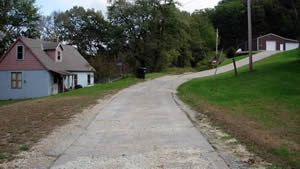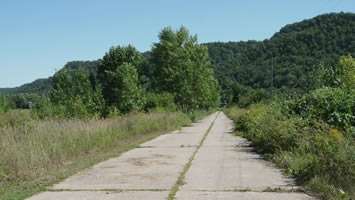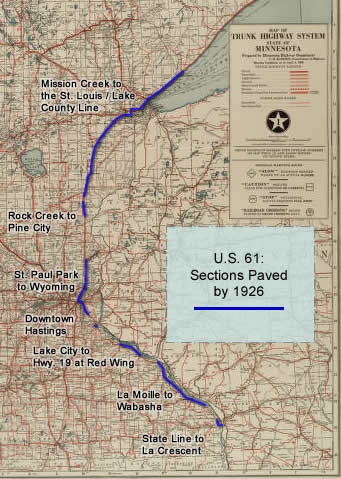

 U.S. 61, Minnesota: Route History.
U.S. 61, Minnesota: Route History.
U.S. Highway 61 is Minnesota's most storied and scenic highway. Its historic route winds beneath the dramatic bluffs of southeastern Minnesota, cuts through the former pine logging region of east-central Minnesota, and journeys along the spectacular north shore of Lake Superior.
One of the original U.S. routes , U.S. 61 once stretched all the way from the southeastern corner of the state near La Crescent to the Canadian border at Pigeon River. Construction of Interstate 35 eventually led to U.S. 61's retirement north of the Twin Cities metro area.

U.S. 61's historic route through Minnesota can be divided into three sections, each with its own distinct identity and purpose (see map, right).
 - The North Shore Drive
- The North Shore Drive

The most famous former section of U.S. 61 in Minnesota was along Lake Superior's spectacular north shore between the Canadian Border and the port city of Duluth. This stretch of the highway was best known as a tourist route, providing access to various state parks and other attractions. This section is now marked as State Highway 61.
 - Duluth to Wyoming
- Duluth to Wyoming

This former section of the route historically served as the primary highway between the port city of Duluth and the Twin Cities metro area (specifically St. Paul). It traveled through a string of small towns along the Northern Pacific Railway. It was replaced by Interstate 35 in the 1960's and 70's.
 - Modern U.S. 61: Wyoming to La Crosse
- Modern U.S. 61: Wyoming to La Crosse

Modern U.S. 61 runs south from its junction with I-35 in Wyoming through St. Paul to the Wisconsin border at the Mississippi River between La Crescent and La Crosse.
The section north of St. Paul is a remnant of the old route to Duluth. It now serves as an alternate route to I-35 through the northeast suburbs of White Bear Lake, Hugo, Forest Lake, and Wyoming.
The southeast section, also known as the Great River Road, parallels the Mississippi River south from St. Paul to La Crescent, stringing together the historic river towns of Hastings, Red Wing, Lake City, Wabasha, and Winona.
Beginnings: 1850's - 1920

A surviving stretch of the 8-foot concrete road
southeast of Winona.
Most of the route that would eventually became U.S. 61 in Minnesota was originally constructed as a series of military roads starting in the 1850's. By 1858, federal agencies had constructed a road along the Mississippi River between St. Paul and La Crosse, as well as a road from St. Paul to Duluth along an alignment closely paralleling the St. Croix and Kettle Rivers.
By 1920, most of U.S. 61's future route had been marked as a series of motor trails - automobile routes marked and promoted by private associations. Nearly the entire road was still gravel or dirt. Some sections, known as "State Roads", were maintained by Minnesota's fledgling Department of Highways. These early "State Roads" were not trunk routes, but local roads more akin to today's County-State-Aid Highways.
The only paved highway (outside of city streets) on the route before 1920 was a nearly 7 mile concrete road leading southeast out of Winona in southeast Minnesota, ending at the tiny town of La Moille. The pavement was a narrow 8-foot strip of concrete, constructed between 1913 and 1914 by Winona County with aid from the State Road program. The pavement itself was narrower than even a single modern traffic lane, and only covered a section of the road grade, the rest of which was probably covered with gravel. Its purpose was to ensure that the road was passable in any weather (not bogged down with mud, etc).
Summary of Motor Trails Along Future U.S. 61 in 1920
Mississippi River Scenic Highway |
On the North Shore Drive and the River Road between La Crosse and St Paul (this trail followed a different route between the Duluth and the Twin Cities). |
|
Scott Highway |
On the North Shore Drive (shown on the 1920 Rand McNally Auto Trails map, but not registered with the Highway Department). |
|
 |
Mississippi Valley Highway |
From a point south of Hastings (at the modern junction of U.S. 61 with Highway 50) to Duluth. |
National Parks Highway |
On the River Road between La Crosse and St. Paul. |
|
 |
Yankee Doodle Highway |
Winona to St. Paul. This highway, promoted by a group of Winona businessmen, was registered with the Highway Department in 1918 during World War 1. It was probably only marked during war time (it is not shown on an auto trails map from 1920). |
Motor trail Information taken from the 1920 Rand McNally Auto Trails Map and registration scans at the Minnesota Digital Library.

 State Routes 1 and 3: 1921-1926
State Routes 1 and 3: 1921-1926
In 1917, the neighboring state of Wisconsin not only created a highway department to secure federal funding for highway construction, but also created the first unified system of numbered trunk routes in the country. Not long thereafter in 1919, Highway Commissioner Charles Babcock proposed an amendment to the state constitution to provide a state-maintained network of 70 numbered routes, referred to as "Constitutional Routes". The amendment was voted into law by the people of Minnesota on November 2, 1920.
In 1921 crews traveled Minnesota's highways surveying for right-of-ways and future construction. They also put up Minnesota's first route markers: yellow squares with a black five-pointed star surrounding the route number. U.S. 61's future route through Minnesota was marked as Constitutional Routes 1 and 3. Route 1 made up the north half between St. Paul and the Canadian Border, while Route 3 made up the southern half between St. Paul and La Crosse along the Mississippi River. The two routes met at the intersection of 6th Street and Mounds Boulevard in the Dayton's Bluff neighborhood on St. Paul's east side (the junction was eventually moved south a few blocks to Kellogg Blvd / 3rd Street in 1931).

A surviving stretch of 18-foot wide concrete south of
Weaver in Wabasha County. This concrete was laid in
1925 as part of the construction of State Route 3, one
year before U.S. 61 was first marked.

Map showing the sections of future U.S. 61 that were
already paved by the end of the 1926 construction season.
With a constitutional mandate and money from the federal highway act of 1921 the Highway Department was finally able to start a major program of highway construction. New roadways were graded, and the most important routes were paved with portland cement concrete. The early concrete pavement was 18 feet wide. This standard was eventually widened to 20 feet after 1928.
The early highway construction projects had a few primary goals in mind, including shortening the distances between points with more efficient alignments, paving with at least gravel, and eliminating at-grade rail crossings. Since early roads usually paralleled major rail lines, they had a tendency to cross the tracks at unplanned intervals. This was especially bad between St. Paul and Duluth, where the old road paralleled the Northern Pacific tracks, crossing them at right-angles every few miles.
By the end of the 1926 construction season, the Highway Department had already completed about 175 miles of concrete paving along U.S. 61's future route (see map, right), while an additional 75 miles along the north shore had been graded in a major feat of engineering.
 Introduction of the U.S. Routes: September, 1926
Introduction of the U.S. Routes: September, 1926
Plans had begun in 1925 for a unified system of marked routes to allow for interstate travel and replace the old motor trails system. After nearly two years of planning and arguing, the AASHO (The American Association of State Highway Officials) approved the new system on November 11, 1926 (Minnesota had jumped the gun a bit and started marking its routes in September (according to a Highway Department press release).
The Highway Department treated the new U.S. routes as a totally separate system from the the already existing state routes on the assumption that the state routes would be used for local travel and the U.S. routes for interstate travel. Thus, the U.S. 61 markers went up on the same posts as the already existing Route 1 and 3 markers. For this reason, all official Highway Department records from this period refer to U.S. 61 as "Trunk Route 1" or "Trunk Route 3".

U.S. 61 route shield on the same post as a Constitutional Route 3 marker. Photographer unknown, from my private collection.
U.S. 61 shared its route with Highways 1 and 3 until May 4, 1934, when the Highway Department expanded and consolidated the trunk highway system, fully incorporating the U.S. routes and eliminating the old redundant state routes.
Completing the First Paved Highway: 1926-1939
As the 1920's and 30's progressed, the Highway Department continued to grade and pave U.S. 61's route. The first section completed was between St. Paul and Duluth, which was fully paved by the end of 1927. The other segments of U.S. 61 took longer to complete, probably owing to the more difficult terrain. The southeast section from La Crosse to St. Paul was mostly complete by about 1930, though it wasn't until 1936 when the last concrete paving and other finishing touches were completed. By the end of 1936, U.S. 61's route was paved with a nearly continuous stretch of portland cement concrete stretching for over 300 miles from the southeast corner of the state to Two Harbors northeast of Duluth. The remainder of the route along the north shore drive was paved with asphalt due to the lighter traffic loads. The last section of asphalt was laid in 1939 through the Pigeon River Indian Reservation near the Canadian border.
Modernization
Starting in the late 1930's, work was begun to expand some of the busiest sections of U.S. 61 into four-lane divided highways. However, only four sections were completed between 1937 and the outbreak of World War 2, limited to a total of about 8 miles. These included a bypass and short divided section at White Bear Lake, and another short divided section on the south side of Forest Lake at the junction with U.S. 8, both completed in 1937. These two projects only totaled about two miles. (There had actually been two short divided segments constructed in the 1920's, one at Red Wing, and one at Hastings, but these had been urban boulevards, and not what could be considered expressways or long-distance highways).
The next two divided upgrade projects were conducted on either end of the highway between La Crosse and St. Paul. A divided highway along the Point Douglas Road on the southeast side of St. Paul was constructed between about 1937 and 1941, and was the longest divided section on U.S. 61 until after World War 2. The highway leading from the Mississippi River to La Crescent was also upgraded in 1941, a project that was marred by the sabotage of a construction crane due to labor conflicts (this information from a MnDOT roadside structure inventory report).

The divided highway south of Winona, completed in 1958.
After World War 2, projects to bring U.S. 61 up to modern standards were started in earnest. The 40's and 50's saw the replacement of the majority of the highways completed in the 1920's and early 1930's. Grades were rebuilt, driving surfaces expanded to 24 feet of asphalt, and site lines made longer. Junctions were improved, and several more divided sections were started.
Major divided highway upgrade projects included:
- The west entrance to Duluth, starting from the town of Scanlon and continuing west down the Thompson Hill, which was expanded to four lanes in projects between 1948 and 1961.
- An extension of the divided highway leading south out of St. Paul to Newport in 1949, and through Cottage Grove to the Mississippi River bottoms just north of Hastings in 1958.
- The highway on the west side of Red Wing between 1952 and 1954.
- St. Paul to White Bear Lake in 1953, with a slight northern extension in 1957.
- A bypass of the Winona area and the river road as far south as Dakota, completed between 1957 and 1958.
- The expressway between Duluth and Two Harbors, completed in 1967.
 The Construction of Interstate 35
The Construction of Interstate 35

The current northern terminus of U.S. 61 at
Wyoming.

State Hwy 61 marker at the Lester River in Duluth.
With the approval of the Interstate Highway System in 1956, U.S. 61's route between the Twin Cities and Duluth was slated for replacement by Interstate 35.
The first section of I-35 between the the Twin Cities and Duluth was completed in the Hinckley / Sandstone area in 1962. Construction continued almost continuously through the rest of the 1960's and early 1970's. The last section of the new freeway linking the two metro areas was completed on the Thompson Hill west of Duluth in 1977. As the interstate was completed the Highway Department (MnDOT after 1976) gradually turned back the old two-lane road and moved U.S. 61's route onto the completed sections of freeway, using U.S. 61 to fill the gaps in the Interstate while it was under construction. I-35 and U.S. 61 eventually became fully synonymous between the town of Wyoming and downtown Duluth, remaining so from 1977 until 1990.
In the late 80's MnDOT began construction on the downtown Duluth bypass, which was to be the final section of I-35 completed in Minnesota. As the project neared completion, MnDOT petitioned the AASHTO to retire U.S. 61 north of the town of Wyoming. The petition was approved in 1990, ending U.S. 61's 60 year role as the route between St. Paul and Duluth. The north shore drive was redesignated as State Highway 61 to retain a link to its historic past, breaking MnDOT's usual rule of not duplicating route numbers.
 Further Improvements on the River Road
Further Improvements on the River Road
While I-35 was being constructed In the 1960's and 70's, MnDOT continued work to expand the river road into an expressway between La Crosse and Wabasha. This work included the construction of a section of Interstate 90 in the Dakota and Dresbach area, just north of La Crescent. The last section of the expressway was finally completed between Minnesota City and Minneiska in 1978, ending the work begun in the late 1950's. However, U.S. 61's role as the main route between St. Paul and La Crosse had already been usurped by the U.S. 52 expressway and its link with Interstate 90.

Traffic flowing freely on the new freeway at Newport.
Although U.S. 61's southeast section has continued to be an important regional route, several two-lane sections and bottlenecks at Hastings, Red Wing, and Lake City have hampered its usefulness as a through highway. Instead, the river road has taken on a role similar to the north shore drive, providing scenic views and vacation destinations for tourists, and access to niche businesses (antiques) in the towns closer to the Twin Cities, especially Red Wing and Lake City. Industrial areas along the Mississippi south of St. Paul and suburban development in the Cottage Grove, Hastings, and Red Wing areas have also contributed to U.S. 61's continuing importance. Improvements to better serve the increased traffic from the Twin Cities have included the extension of the divided highway on the west side of Red Wing as far west as Highway 19 in 1983, and west through the Cannon River Valley to Highway 316 between 1993 and 1997.
The largest recent project was the massive reconstruction and freeway upgrade of U.S. 61 through Newport and St. Paul Park, done in conjunction with the replacement of the Wakota Bridge (originally constructed in 1959 for I-494). U.S. 61's upgrade was completed in 2005.
Replacement of the Hastings Bridge

The old Hastings High Bridge, 2005.
The old Hastings High Bridge was replaced between 2010 and 2013 by a new freestanding tied-arch bridge, the longest of its kind in the world. MnDOT is currently putting the finishing touches on the new span, and expects to complete it in the spring of 2014. The project web page can be found here. The old bridge, opened in 1951, had originally been slated for replacement in 2019. However, its poor condition and fracture-critical design pushed it to the top of the priority list, due in no small part to the collapse of the similarly fracture-critical I-35W bridge in 2007. The old bridge is now being dismantled.
I-90 Dresbach Bridge Replacement and Interchange Reconstruction
Reconstruction is currently underway on U.S. 61's south interchange with I-90 near Dresbach, replacing the original interchange built in the early 1960's. The project web site can be found here.
Future Changes to U.S. 61
MnDOT's metro district, in an attempt to reduce trunk highway mileage, has slated the remaining section of U.S. 61 between St. Paul and Wyoming for turnback by 2030 if finances are not constrained. This would eliminate the final section of U.S. 61's old route between St. Paul and Duluth. MnDOT would also like to turn back U.S. 61 in southern Dakota County between the two junctions with State Highway 316, which is the least traveled section of the route between La Crosse and St. Paul. Highway 316, which serves as a short cut, now carries the majority of traffic. U.S. 61 would most likely take over Highway 316's roadway in this eventuality.
Development near Lake City has begun to put pressure on the longest surviving two lane section between Red Wing and Wabasha along the south shore of Lake Pepin, causing MnDOT to begin looking into options for improvements (see the corridor management study here.)
